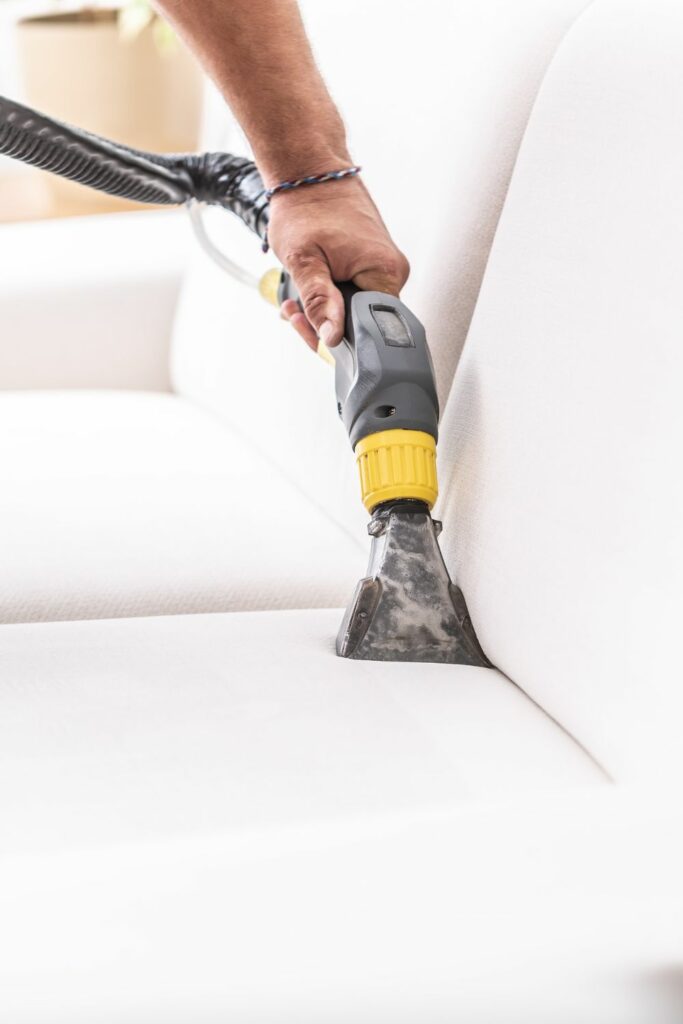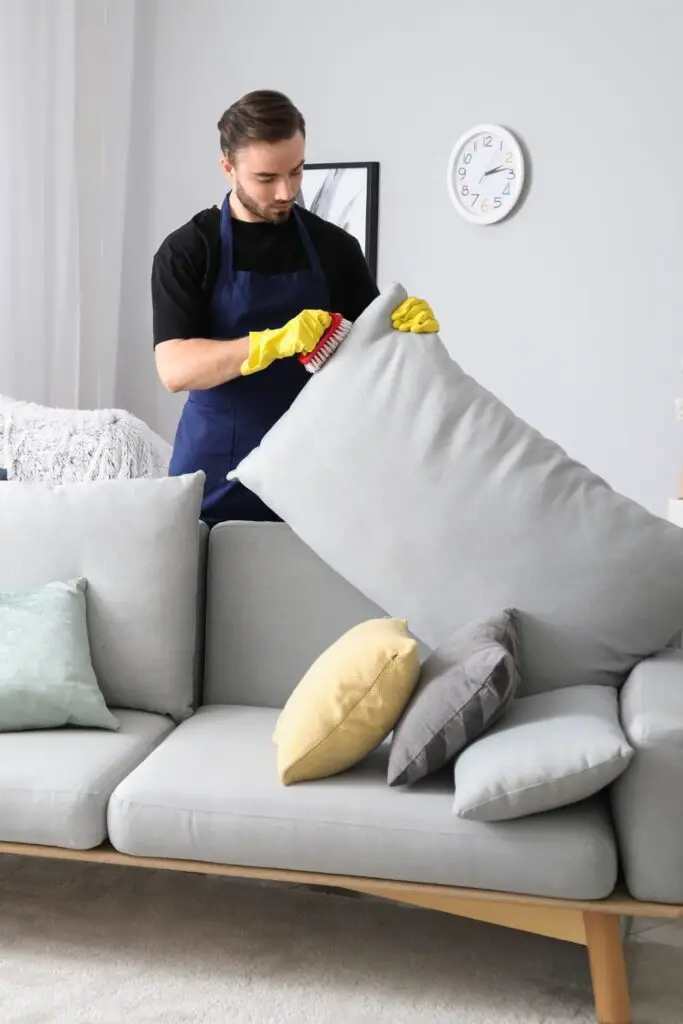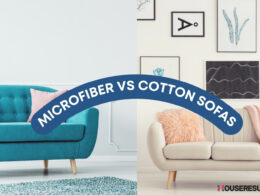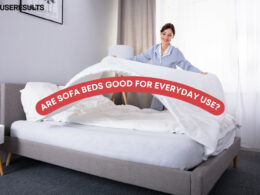Table of Contents Show
Over the years, I’ve had the privilege of working on numerous home improvement projects and addressing the challenges homeowners face daily. One recurring topic, both as a homeowner and a contractor, has been the care and maintenance of sofa cushions.
We invest quite a bit in our sofas, expecting them to last for years while maintaining their comfort and aesthetics. But when it comes to cleaning, there’s often a cloud of uncertainty, especially around the topic of dry cleaning. Can sofa cushions be dry-cleaned? Well, it’s not a straightforward answer.
This guide aims to shed light on this very subject, providing clarity using a simple yet professional approach. So, whether you’ve just spilled wine on your brand-new couch or you’re giving an old favorite a refresh, let’s get to the heart of the matter together.
Quick Answer
Yes, sofa cushions can be dry cleaned, but it largely depends on the fabric type, cushion construction, and the presence of specific stains. Always check the manufacturer’s care labels for guidance and consider consulting a professional dry cleaner for the best results.
Can Sofa Cushions be Dry-Cleaned?
If there’s one thing I’ve learned from my extensive experience in home care and improvement, it’s that there rarely are one-size-fits-all answers. This is especially true when we talk about cleaning sofa cushions.
The short answer to the question “Can sofa cushions be dry-cleaned?” is, quite simply, it depends. Several factors come into play, and understanding these will guide you to make the right choice for your furniture.
1. Fabric Type

The kind of fabric your sofa cushions are made of is the primary determiner. While materials like polyester or synthetic blends may respond well to dry cleaning, natural fibers like silk or wool can be more delicate and might not fare as well.
2. Cushion Construction
How your cushion is constructed matters. Some have removable covers, making the cleaning process more manageable. Others are fixed, and cleaning them could mean exposing the inner materials to chemicals.
3. Presence of Stains
The type of stain on your cushion could also dictate the cleaning method. Some stains are better tackled with specific cleaning processes rather than dry cleaning.
According to a study published in the Journal of Textile and Apparel, Technology and Management, the efficacy of dry cleaning can vary significantly based on the nature of the fabric and the kind of stain it’s subjected to.
The study emphasized that while dry cleaning can be an excellent solution for certain materials and stains, it’s not universally applicable. Therefore, understanding the specifics of your cushion fabric and the nature of any stains is crucial before deciding on a cleaning approach.
It’s essential to be informed and, when in doubt, seek professional guidance. A well-informed decision can extend the lifespan of your beloved sofa cushions while ensuring they look their best.
Benefits of Dry Cleaning Sofa Cushions
When homeowners ask me about the best methods to care for their furniture, dry cleaning often comes up in the conversation. While it’s not the solution for every type of fabric or cushion, there are undeniable benefits to this method. Let’s discuss some of the prominent advantages of dry cleaning your sofa cushions:
1. Extending Cushion Lifespan
One of the foremost reasons many opt for dry cleaning is its potential to extend the lifespan of the cushion. Dry cleaning uses solvents instead of water, which can often be gentler on certain fabrics.
Over time, less abrasive cleaning can mean fewer signs of wear and tear, allowing your cushions to stay plump and comfortable for longer.
2. Maintaining Vibrant Colors and Patterns
There’s nothing quite as disappointing as seeing a beautiful, vibrant sofa fade prematurely. The good news is that dry cleaning can help maintain those rich colors and intricate patterns.
The chemicals used in the dry cleaning process are less likely to cause color bleeding or fading compared to traditional water-based cleaning methods. So, if you’ve got a sofa with a color or pattern you love, dry cleaning might just be the way to keep it looking fresh and vivid.
3. Reducing the Risk of Shrinkage or Fabric Damage
We’ve all heard stories or perhaps experienced it firsthand: a cushion cover that, after a wash, seems to have shrunk or lost its shape. Water can sometimes cause fabrics to contract or warp. Dry cleaning eliminates the use of water, drastically reducing the chances of your cushion covers shrinking or getting distorted.
In the realm of home care and furniture maintenance, understanding the tools and techniques at our disposal is half the battle. Dry cleaning offers a range of benefits that, when applied judiciously and based on the fabric type, can genuinely enhance the life and look of your sofa cushions.
How to Determine If Your Sofa Cushions Can Be Dry Cleaned
As someone deeply immersed in home improvements and care, I often emphasize to my clients: that knowledge is power. And when it comes to the well-being of your sofa cushions, this sentiment couldn’t be more accurate.
It’s not enough to simply know the benefits of dry cleaning; one must also discern when and where it’s applicable. Here’s a systematic approach to determine if your sofa cushions are suitable candidates for dry cleaning:

1. Reading and Understanding Care Labels
It may seem rudimentary, but it’s surprising how often this step is overlooked. Manufacturers often provide care labels on furniture, giving explicit cleaning instructions.
These labels typically have symbols indicating whether the item is suitable for dry cleaning, machine washing, or other cleaning methods. Familiarize yourself with these symbols, and if you spot the one for dry cleaning, you’re on the right track.
2. Doing a Spot Test
If you’re uncertain or the care label is missing, doing a spot test is a prudent next step. Choose a hidden section of the cushion cover, preferably at the back or bottom. Apply a small amount of dry cleaning solvent using a white cloth, then dab gently.
Wait for it to dry, and observe any changes in color, texture, or any adverse reactions. If everything seems normal, it’s a positive sign that the entire cushion can handle the process.
3. Consulting with Professional Dry Cleaners
When in doubt, turn to the experts. A seasoned dry cleaner has likely encountered a wide range of fabrics and cushion types. By examining your cushion, they can provide insights based on their experience. Additionally, they might offer valuable advice on potential risks or best practices tailored to your specific cushion fabric.
Deciding on a cleaning method for your sofa cushions is no small task. The goal is always to preserve the life and beauty of your furniture and armed with the right information, you’re well on your way to making the best decision.
Alternatives to Dry Cleaning
Throughout my journey as a contractor, I’ve often had homeowners voice concerns about dry cleaning, be it due to cost, environmental concerns, or simply personal preferences. It’s worth noting that dry cleaning is just one of many options available to maintain your sofa cushions. There are several other methods, each with its own set of advantages. Let’s explore some of the notable alternatives to dry cleaning:
1. Steam Cleaning
Steam cleaning, also known as hot water extraction, uses hot water vapor to loosen and dissolve dirt in fabrics. It’s a method that not only cleans but also disinfects, making it particularly effective for households with allergies or sensitivities.
While it offers deep cleaning, it’s essential to ensure your cushion fabric can handle moisture without risk of damage or shrinkage.
2. Hand Washing
For those who prefer a gentler, more hands-on approach, handwashing might be the answer. Using lukewarm water and a mild detergent, you can clean your cushions manually, giving you control over the process.
It’s particularly suitable for delicate fabrics that might not withstand machine washing or aggressive cleaning methods.
3. Vacuuming and Spot Cleaning

Regular maintenance can work wonders in keeping your sofa cushions in pristine condition. A routine vacuum can pick up dust, pet hair, and other everyday debris, while spot cleaning can address specific stains or spills as they happen. For spot cleaning, always use a mild cleaner and test on an inconspicuous area first.
4. Professional Upholstery Cleaning Services
If you’re looking for a comprehensive solution without the DIY aspect, professional upholstery cleaning services might be the way to go.
These experts have specialized equipment and knowledge to treat various fabrics and conditions, ensuring your cushions get the best care possible.
The heart of home care lies in choices—understanding the array of methods available and selecting the one that aligns with your needs and preferences. Whether you choose dry cleaning or one of its alternatives, the goal remains consistent: to keep your sofa cushions looking and feeling their best for years to come.













